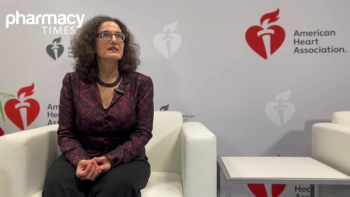
Comparing Front-Line Renal Cell Carcinoma Combination Regimens Without Head-to-Head Studies
With a lack of head-to-head studies comparing combination regimens in frontline metastatic renal cell carcinoma, deciding on how to choose the right regimen can pose a challenge.
In recent years, the treatment of frontline metastatic renal cell carcinoma (RCC) has changed from immune checkpoint inhibitor monotherapies to combination regimens, explained Alison Palumbo, PharmD, MPH, BCOP, during a panel discussion at the
Palumbo noted that the combination regimens currently designated category 1 for National Comprehensive Cancer Network (NCCN) are cabozantinib (Cabometyx; Exelixis, Inc) plus nivolumab (Opdivo; Bristol-Myers Squibb Company), lenvatinib (Lenvima, Eisai) plus pembrolizumab (Keytruda, Merck), pembrolizumab plus axitinib (Inlyta; Pfizer Inc), and ipilimumab (Yervoy; Bristol-Myers Squibb Company) plus nivolumab.
To demonstrate the use of each combination therapy, Palumbo noted that it can be beneficial to explain their use by first discussing a case study outlining a real-world example from treatment with a patient with frontline metastatic RCC.
“So, let's jump right into some cases. XX is a 61-year-old female with a history of poorly controlled diabetes, hypertension, and obesity. She is status post nephrectomy for pT1NxMO clear cell carcinoma of the kidney that was diagnosed in 2011,” Palumbo said.
Palumbo noted that the patient first presented after a fall with severe right-sided hip pain.
“Imaging demonstrated a right femoral neck fracture, and the biopsy of the femoral neck is consistent with clear cell carcinoma,” Palumbo said. “The patient then underwent a right hemiarthroplasty. Further imaging showed evidence of a lytic T4 lesion, left upper lobe 2 centimeters pulmonary lesion hilar/mediastinal lymphadenopathy, and a possible C2 lesion. Her [Eastern Cooperative Oncology Group (ECOG)] is 2.”
Jacqueline Vuky, MD, another participant in the panel discussion, noted that this was from her patient panel from within the past couple months.
“I had a really hard time trying to figure out what to do with this patient. As a medical oncologist, when we first see someone like this, particularly for RCC, the first thing we think about is risk stratification for these patients,” Vuky said. “We want to have an idea of prognostically how they’re doing, and then this really also informs what treatment options are available.”
Specifically, because this patient has at least 1 poor prognostic feature, which is ECOG of 2, and she also had hypercalcemia and anemia, Vuky noted that the patient had a poor prognostic and could not fit into any of the 4 categories for RCC treatment.
“The other thing that we can think about is really, even though there are no randomized trials comparing the 4 regimens, you think about the need for symptomatic palliation,” Vuky said. “So this patient, she is symptomatic, obviously, she broke her hip, she also has neck pain from that C2 lesion. So I'm going to probably be thinking about treatments that have a better response rate or a faster response rate. So in that way, [tyrosine kinase inhibitors (TKI)] and [immunotherapy] combination probably would be better.”
Panelist David Hughes, PharmD, BCOP, noted in response that when it comes to first-line management, there are 3 options: pembrolizumab plus axitinib, cabozantinib plus nivolumab, and ipilimumab plus nivolumab.
“It becomes hard to distinguish which of these combinations to use in practice,” Hughes said. “They're all compared to sunitinib, which arguably should probably be the last time you use it to compare. But these are not compared head-to-head, so can you really say 1 combination is superior or better than the other. Unfortunately, we're going to have to make some sort of cross-trial comparison or at least use some clinical judgment to say what are some of the things we can think about as we make those therapy decisions.”
Additionally, Hughes pointed out an additional hurdle with cross-trial comparisons to determine the appropriate combination therapy for a patient is that baseline characteristics do not often appropriately note the representation of non-White patients in cancer clinical trials.
“In this trial, they reported 19% non-White. When you look at the first readout at 2 years, there was an overall survival benefit that was maintained, and I think they're just shy of 4-year rollout for axitinib plus pembrolizumab. Interestingly, we look at the subgroup analysis of KEYNOTE-426, again, the subgroups are exploratory, but the non-White subgroup did not perform favorably across the 1 bar in the hazard ratio,” Hughes said.
Another thing to consider when comparing trial results is discontinuation rates, Hughes explained.
“TKIs are not the easiest drugs in the world to tolerate. Usually you see hypertension, gastrointestinal distress, skin toxicity from any of these inhibitors,” Hughes said. “Axitinib is a drug that is strictly VEGFR–1 through VEGFR–3, and it really doesn't have many off target effects like some of the other agents do. So, when you look at drug interruptions and dose goals, you're looking at about 40%, with about 40% with sunitinib, but that's generally the framework for axitinib.”
The second combination that was approved was cabozantinib plus nivolumab from the CheckMate-9ER trial, which compared cabozantinib at 40 milligrams plus nivolumab in the untreated patient population compared to sunitinib, Hughes noted.
“Here you see a slightly higher percentage of patients with specifically poor risk. As Dr. Vuky mentioned earlier, here you see very similar trends. In overall survival, you see slight differences in adverse events, you see slightly more diarrhea in the cabozantinib plus nivolumab arm,” Hughes said. “But overall, you're seeing a very nice benefit with it.”
In the third combination based on the CLEAR trial, which is the most recent trial conducted investigating lenvatinib plus pembrolizumab versus sunitinib, lenvatinib started at a dose of 20 milligrams in combination with pembrolizumab, Hughes explained.
“Here you're seeing a similar patient population, making the best cross-trial comparison we can. But you're seeing a similar amount of poor-risk features in the baseline characteristics. You are seeing progression-free survival here,” Hughes said. “Lenvatinib did have a significant amount of dose interruptions and dose reductions, so I think that’s really important. When you think about the mechanism of action, you're seeing FGFR2 inhibition here, so you are seeing some electrolyte abnormalities with phosphorus, so you can see some other impairments with a lenvatinib.”
Hughes noted that at the end of the day, these differences in the clinical trials are rather small and the combination therapies are overall quite similar, making it really important to figure out how you’re going to pick the therapy for a patient.
“My thought process has always been, ‘Let's pick one as an institute and get really good at it,’” Hughes said. “As far as managing adverse events, know how to drop the dose, know how to manage the adverse effect profiles that come with them, and then make your decision from there.”
REFERENCE
Bobolts L, Hughes D, Vuky J, Palumbo A. Dealer’s Choice: Comparison of Front-Line Renal Cell Carcinoma Regimens. San Diego, CA: 2022 ATOPP Summit; July 15, 2022.
Newsletter
Stay informed on drug updates, treatment guidelines, and pharmacy practice trends—subscribe to Pharmacy Times for weekly clinical insights.
















































































































































































































